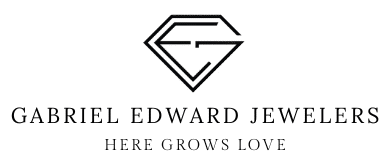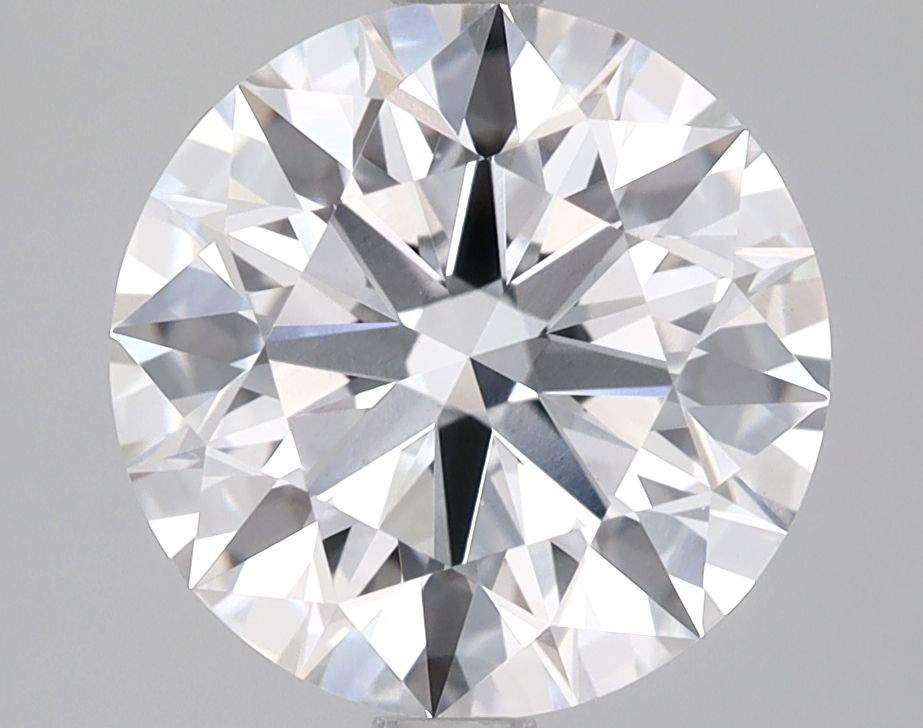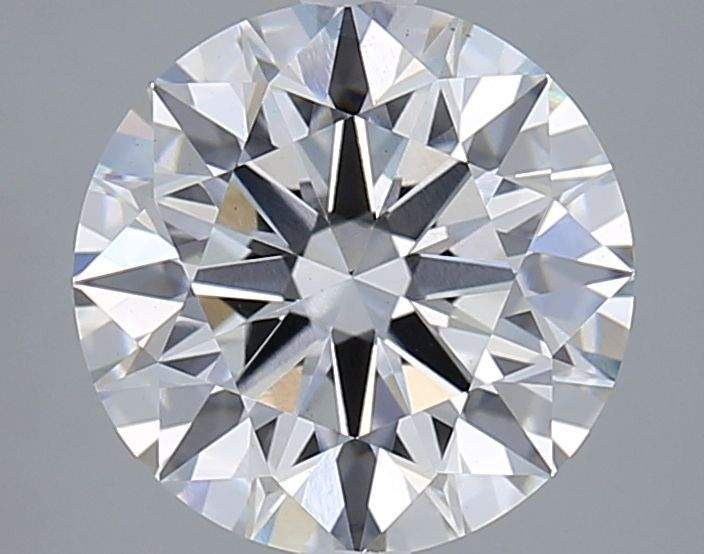How To Buy The PERFECT
Round Diamond Engagement Ring
Round Diamonds are the 90s Bulls of Engagement Ring Diamond shapes. Transcendent, immortal, shining to a blinding level. It doesn’t get more classic than a Round Diamond. Luckily, you only need one, not six.
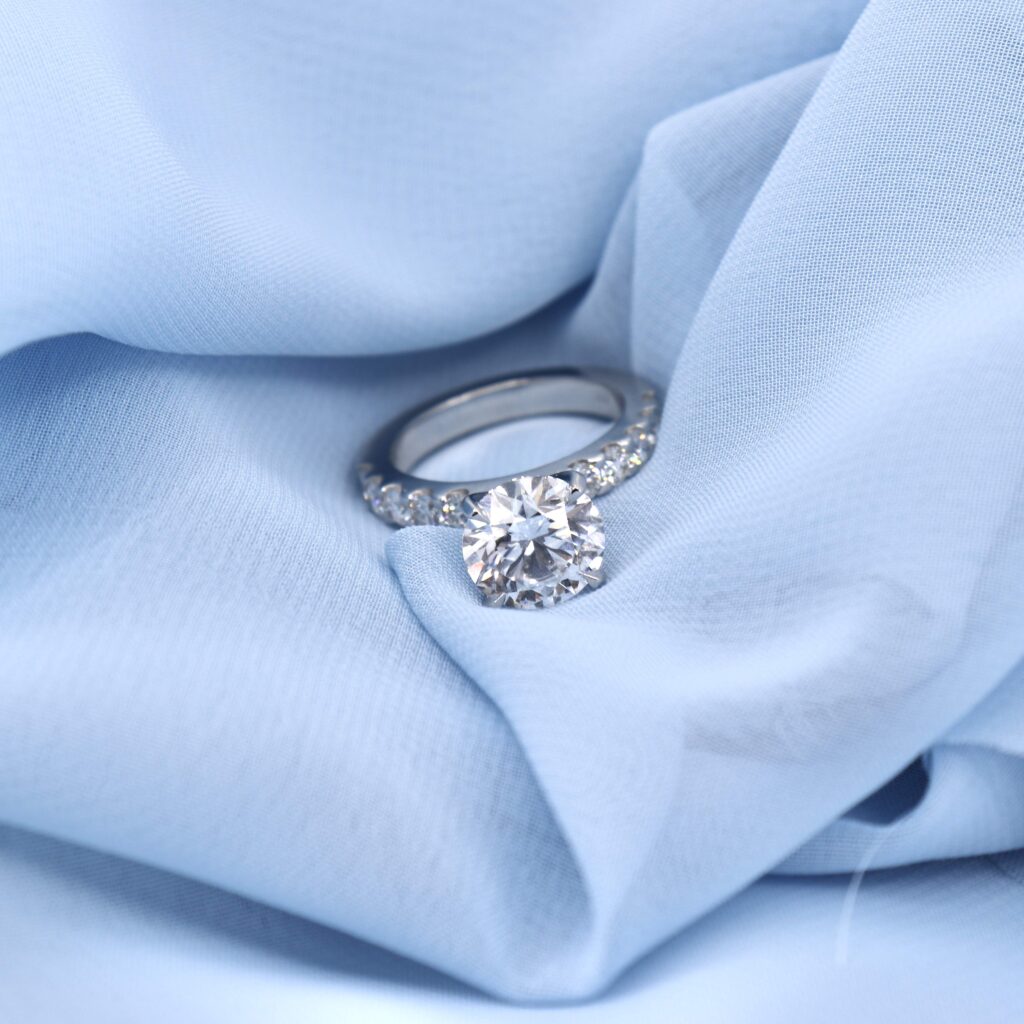
- Scouting Report: The best light return and Color / Clarity masking of all Diamond shapes, good surface area by Carat Weight, a classic and forever elegant Diamond. Goes great with all Setting styles (Solitaire, Top Halo, Hidden Halo, Diamond Band, etc.)
- Needs improvement: No flaws in a Round Diamond’s game. Only point deduction is it won’t look as large as an elongated shape (Oval, Marquise, Pear, elongated Cushion or Radiant, Emerald-cut) of the same Carat Weight.
- Popularity Rank (Current): #3
- Surface Area of a 1 carat : 33.18 mm
- Surface Area / Carat Weight Rank:
- Light Return Rank: #1 (Behind only the Sun)
Want the quick steps instead of reading the whole Playbook? We got you covered.
- Set Cut Grade “Ideal”
- Set Color Grade from “E” – “F”
- Set Clarity Grade to “VS1”
- Open Advanced Filters and set Polish and Symmetry to “Excellent”
- Set Price to your ideal budget for the whole Ring, minus a $1,000 buffer for the Setting
- Select “IGI” as the Lab
- Set Depth from 59-63%
- Set Table from 54-58%
- Manually check that Crown Angle is between 34.0 – 35.5°
- Manually check that Pavilion Angle is between 40.6 – 41.0°
- Manually check that Lower Girdle Facet Length is between 75-80%
- Manually check that Star Facet Length is between 45-55%
- Manually check that the Diamond is CVD Type IIA (always passes diamond tester)
- Set your Carat Weight range. Factor in:
- How large of a Diamond she’s comfortable wearing
- How large of a Diamond looks nice but not “overpowering”
- The cost of the Setting (let’s say roughly $1,000)
Cut Quality of a Round Diamond
The Cut Grade of an IGI graded Lab-Grown Round Diamond should only be “Ideal”. Rounds are the only shape to receive an official “Ideal” Cut Grade on their IGI Reports. An “Ideal” Cut Grade means maximum light return from all areas of the Diamond, perfect scintillation (contrast between white and black spots which shimmer as the Diamond or its light source moves), perfect balance of fire (rainbow-colored light) and brilliance (white light).
Let’s look at a real “Ideal” Cut Round Diamond and its IGI Report below…
Here it is at 100X zoom. This is “E” Color and “VS1” Clarity- and don’t worry- none of those imperfections are even slightly visible to the naked eye.

The IGI doesn’t list a formal Proportions chart for a perfectly-cut Round Diamond, that’s what the “Ideal” Cut Grade is for.
But, we have our own recommendations to pick from the crème-de-la-crème.
- Table % should be between 54-58%. It’s 57% in the Report above ✅ Optimal light received into the Diamond.
- Depth % should be between 59-63%. It’s 62.5% in the Report above ✅ Optimal Carat Weight distribution, no shadows, and Diamond looks like a proper 3 carat (overly-deep Diamonds look smaller once set in a Ring, since most of the weight is on the bottom, which you can’t see).
- Crown Angle should be between 34.0 – 35.5°. It’s 34.5 in the Report above ✅ Optimal balance between fire (rainbow-colored light) and brilliance (white light). Too much brilliance and the Diamond looks “glassy”, too much fire and it looks like a Moissanite.
- Crown is a Diamond’s top half, above the girdle.
- Pavilion Angle should be between 40.6 – 41.0°. It’s 41.0° in the Report above ✅ Maximum volume of light is being reflected from the Diamond.
- Pavilion is a Diamond’s bottom half, below the girdle.
- Girdle should be anywhere from Thin to Slightly Thick. It’s Medium to Slightly Thick in the Report above ✅ The Diamond is durable and bears no risk of chipping while being set in your Ring.
- Girdle is the Diamond’s border dividing crown and pavilion.
- Polish should only be “Excellent”, and it is so in the Report above ✅ Each of the Diamond’s facets are polished to the highest degree possible.
- Symmetry should only be “Excellent”, and it is so in the Report above ✅ If you split the Diamond in half, right down the middle, one side would look exactly like the other. Fire, brilliance and scintillation (contrast between light and dark areas) are displayed evenly.
- Cutlet should either be “None” or “Pointed” and it’s “Pointed in the Report above ✅ The pavilion facets all meet at the pointy bottom of the Diamond, which has been cut proportionally and isn’t visible when looking down at the Diamond.
When you’re searching for a Diamond online, let the Report be your guide. If you’re unsure or just want to confirm the Diamond’s a beauty, call or text us @ 305-796-6143.
“Ideal” Cut Round Diamond Under ASET Scope
An ASET (Angular Spectrum Evaluation Tool) evaluates how well a Diamond interacts with light. Under ASET Scope, you want to see a lot of red, a little green, strategic and symmetrically-placed blue and almost no white. We double-check your Diamond under ASET Scope before setting in your Ring. If you picked out a Diamond with subpar light performance, we’ll get in contact, and suggest a better Diamond at the best price possible.
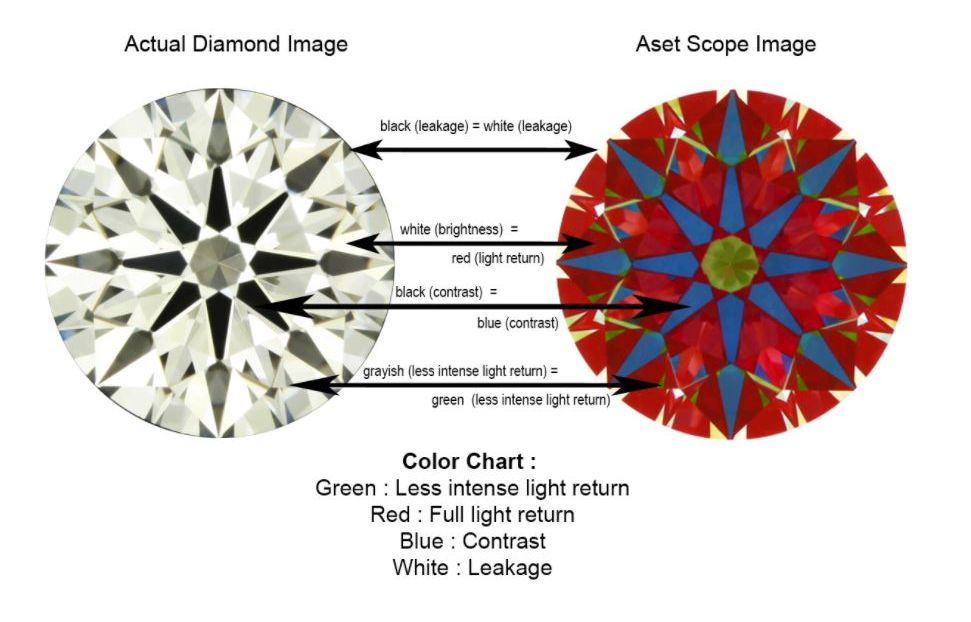
Quick Note:
“Super Ideal” is NOT an official Cut Grade, but a marketing tool used by jewelers to promote a Diamond. It’s subjective, and we recommend only comparing Diamonds based on their Reports’ official Cut Grade and Proportions.
Set Cut Grade to “Ideal”, Table from 54-58% and Depth from 59-63%.
On the IGI Report, check Crown Angle (34.0 – 35.5°) and Pavilion Angle (40.6 – 41.0°).
What’s the best Color Grade for my
Round Diamond Ring?
A “D” Color Diamond has no hue, like a drop of water. Every grade going down the alphabet from there has a bit more included yellow or brown hue. D, E and F are known as the “Colorless” Range, and with Fancy-shape (non-Round) Diamonds, the sweet spot is “E”, a crisp white Color without the extra $500-$1,000+ of a “D” Color stone.
BUT, an “Ideal” Cut Round Diamond will reflect so much light that the added hues of Color are much less noticeable. In this case, an “F” Color will look crisp white as well.
Here it’s totally up to you. If you’re cutting it close to your budget, you’re more than fine with an “F” Color. If you’ve got the room, an “E” Color’s an even crisper white. As always, no need for “D” Color unless you really want to. There’s a marginal visual difference between D and E but the price difference could be $500-$1,000 or more.
Set your Color Grade from to “E” – “F” and move on to the next step.
What’s the best Clarity Grade for my
Round Diamond Ring?
Clarity is the least important of the 4 Cs. All that you care about in terms of Clarity is that your Diamond is eye-clean. An eye-clean Diamond has no imperfections that are visible to the naked eye. If you can’t see it without a jeweler’s loupe/microscope/etc., you shouldn’t be paying for it (in my opinion).
The best Clarity Grade for your Round Diamond Engagement Ring is “VS1”, short for “Very Slightly Included (1)”. Straight from the GIA, VS1 Diamonds contain “inclusions that are minor and range from difficult to somewhat easy for a skilled grader to see under 10X magnification”. VS1 Clarity Grade will be eye-clean on practically any Round Diamond size you’d use for an Engagement Ring. As with Color Grade, a Round Diamond’s sparkle will mask Clarity imperfections better than any other shape, so Clarity is of very little concern. No need to get a VVS1 or 2 Diamond to avoid visible imperfections.
Below, VVS1, VVS2 and VS1 Clarity 3 carat Round Diamonds. Can you tell the difference? Neither can I 😊

3.06 carat IGI graded “VVS1″ Clarity
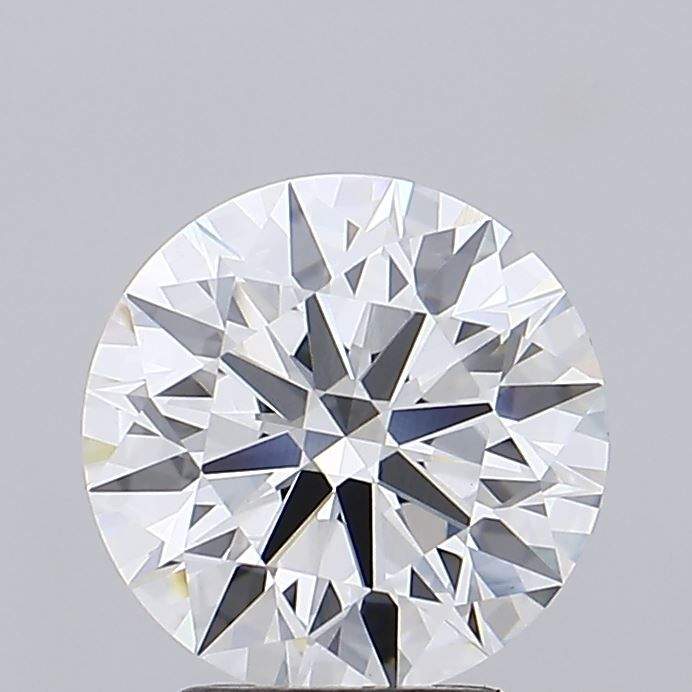
3.08 carat IGI graded “VVS2″ Clarity
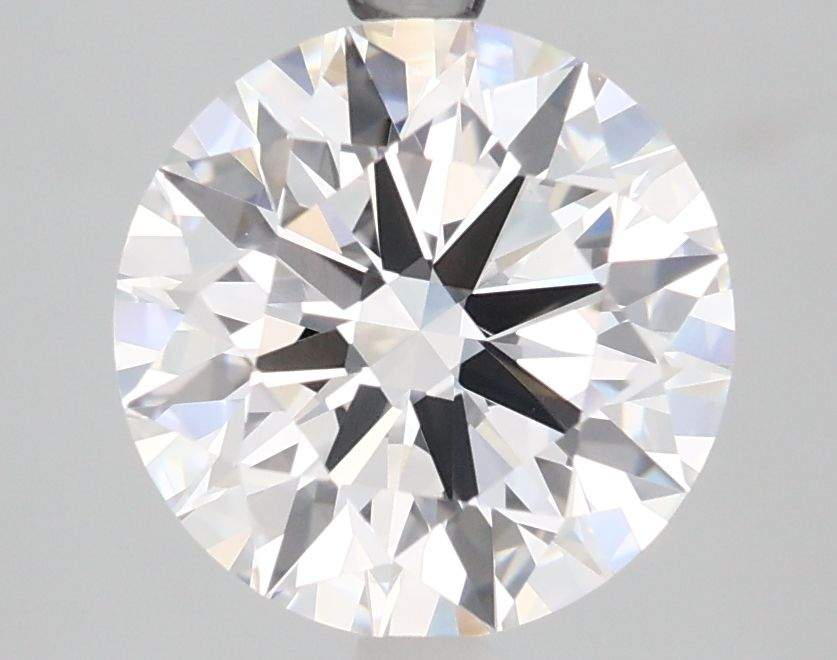
3.09 carat IGI graded “VS1″ Clarity
No one can tell the difference between VVS2 (or higher) Clarity and VS1 Clarity with their eyes. Even under 10X zoom, you’re paying $500+ for one or two less specks.
Set your Clarity Grade filter to “VS1”.
What’s the right Carat Weight for my
Round Diamond?
This one’s totally up to you. A 5 or 6 carat Diamond might fit within your budget range, but is your lady comfortable wearing that? Do you live in a well-lit neighborhood?? Is she packing heat???

Left to right: 4.00 carats (E Color and VS2 Clarity), 3.50 carats (F Color and VS1 Clarity), 3.05 carats (E Color and VS1 Clarity), 2.57 carats (E Color and VS1 Clarity), 2.09 carats (E Color and VS1 Clarity)
All IGI graded Lab-Grown Diamonds, “Ideal” Cut, E Color and VS1 Clarity
Ivana’s a finger size 6!
If you’re unsure of what size Diamond she wants, ask her. Bring it up casually. Show her a Ring from our Instagram around the size you’re shopping and see what she thinks of the main Diamond. Too big? Too small? Just right? Show her a few, see which one she thinks looks best.
With Lab-Grown Diamonds, the sweet spot seems to be between 3 and 4 carats. Not too big, and definitely not too small. Yes, some couples go with 2 carat Diamonds. And others go with 5, 6 and 7 carat Diamonds. Don’t worry about what everyone else is wearing- pick the right Diamond for you. Diamonds symbolize forever with your soulmate- no matter how big they are.
Set your Carat Weight range (3.00 – 3.25 carats if you’re unsure).
